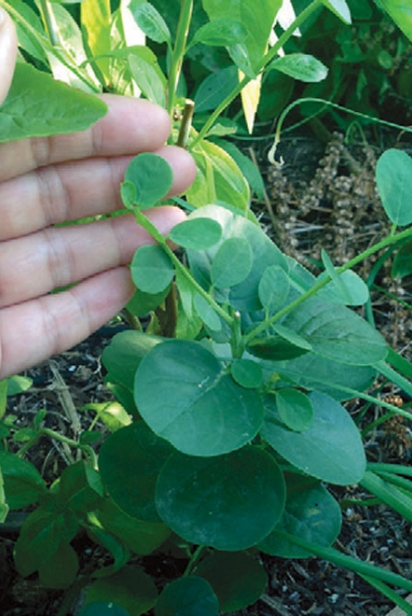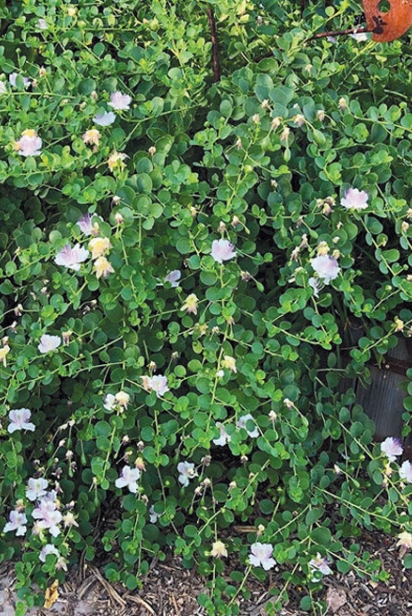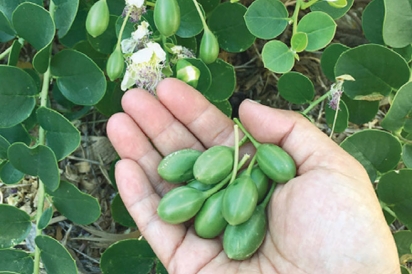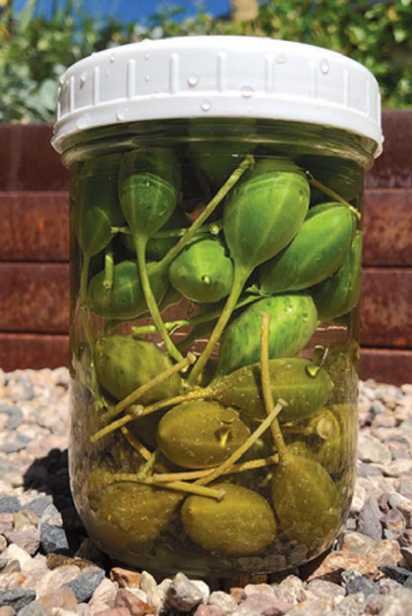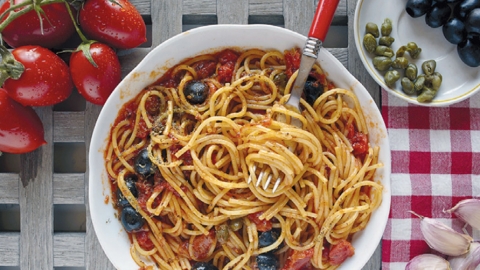The Great Caper Caper
How One Woman Brought a Mediterranean Crop to the Valley of the Sun
Capers are a pantry staple in the kitchen of anyone who regularly cooks Southern Italian or Greek food. The tiny buds add a punch of briny, piquant flavor to everything from puttanesca sauce to piccata (veal, chicken or otherwise) or even a Sunday- morning bagel and lox. The plants (Capparis spinosa) grow wild on arid hillsides and in rocky crevices throughout the Mediterranean basin, and for the past 10 years they’ve also thrived in the Valley of the Sun.
That’s largely due to the patience and dedication of Suzanne Vilardi, who owns Vilardi Gardens, a wholesale bedding plant nursery in Scottsdale.
Vilardi—who laughs that if she can’t eat it, she doesn’t grow it—was enamored of capers for their culinary uses, but couldn’t find anyone who was growing them locally. About 15 years ago, she set out on a quest to raise the plants herself. She started with a packet of dried seeds. But not realizing that the seeds are hyperdormant and require lots of babying to germinate, Vilardi was disappointed when the experiment didn’t come to fruition.
Ever resourceful and not easily daunted, she next tried ordering plants from a nursery in Canada. They arrived weak and sickly-looking, but of the six she bought, two of the plants survived in pots. They survived, but they didn’t thrive. After a couple of years, Vilardi handed them off to her friend Catherine “The Herb Lady” Crowley, who planted them in the ground in her yard. After a couple of growing seasons, they took off, and Vilardi harvested very ripe berries from Crowley’s plants to try her hand at germinating the seeds again. This time it was a success; since then, Vilardi has become one of only a handful of caper plant growers in the entire country.
The process requires patience. Each caper berry contains as many as 200 seeds, which have to be cold-treated in order to germinate. Vilardi keeps hers in the refrigerator for two weeks. (Last year she lost her crop when she left them too long and the seeds molded.) She then plants them in propagation trays containing a potting medium that includes parboiled rice hulls for drainage, rather than perlite, and lets them sit. It takes about 22 weeks for the seeds to germinate, and then they grow very slowly, remaining the size of a pea for another three months or so. Eventually they’re big enough to transplant into three-anda-half-inch containers, and then finally, about nine months after sowing, into five-inch pots. At that point, which usually coincides with warm weather, the plants take off and grow quickly.
Vilardi says caper plants do best in well-drained soil, planted either in the ground or in containers, but they require lots of space: six feet on all sides for in-ground planting, or a minimum 25-gallon pot. Initially, the young plants will need temporary shade and plenty of water, but once they become established, they’re heat tolerant and drought resistant. Deep watering helps develop a long, resilient root system. She suggests pruning the caper plants back every January after the first year. It will take several growing seasons for the plants to start displaying their showy blooms and, as long as pollinators are present, setting fruit.
“It’s a long-term journey and a labor of love,” she says. But one mature plant can yield as much as 10 pounds of buds or 20 pounds of berries.
Once the plants start to bud, a gardener has to make decisions. Most commercial capers, farmed mostly in poorer Mediterranean countries, are buds harvested before the plants bloom. They’re graded according to size, with nonpareils, the smallest and youngest, being the most expensive and sought-after. But caper berries are popular also, and the flowers are eye-catching, so some leave the buds to bloom and form fruit. After the buds, berries and even the young leaves are harvested, they’re preserved by pickling. Vilardi says she likes to make a tartar sauce with a little grated onion, chopped caper berries, a bit of lemon juice and mayonnaise. The leaves add a tasty bite to a Greek salad.
This year, Vilardi has raised almost 600 caper seedlings, and most will be available at retail through Summer Winds Nurseries in Arizona. The price can range from $20 to $80 per plant, and they should be available no later than mid-summer. Many Valley chefs have started growing capers in their gardens thanks to Vilardi, and farmer Frank Martin of Crooked Sky Farms planted 100 plants in 2018 in an effort to begin commercial production.
Vilardi hosts an active Facebook group, Low Desert Caper Growers, with about 400 members who share growing tips, recipes and their love of capers, and she offers plenty of information on her website, vilardigardens.com.
Impact of COVID-19
Although the pandemic initially impacted Vilardi Gardens severely due to the cancellation of major planned plant sales, the increased demand for plants from homebound gardeners has kept the company remarkably busy. Vilardi has added on-line ordering of vegetable starts to the website and offers plant delivery within a defined area (subject to minimums).
How to Pickle Capers
Rinse and sort the freshly harvested buds, berries or leaves to remove dust and debris.
Soak in water for three to five days, changing the water every day, to remove any bitterness.
Dry the capers, measure and place in jars.
In a saucepan, combine apple cider or white wine vinegar and water in amounts equal to the amount of capers, then add 1 tablespoon of salt per cup of liquid. Bring to a boil until the salt is dissolved. Cool for 30 minutes, then pour over the capers in the jars. Secure the lids, then refrigerate for at least a week. The longer they sit, the better they get.
For long-term storage without refrigeration, process the jars in a water bath for 10 minutes.



